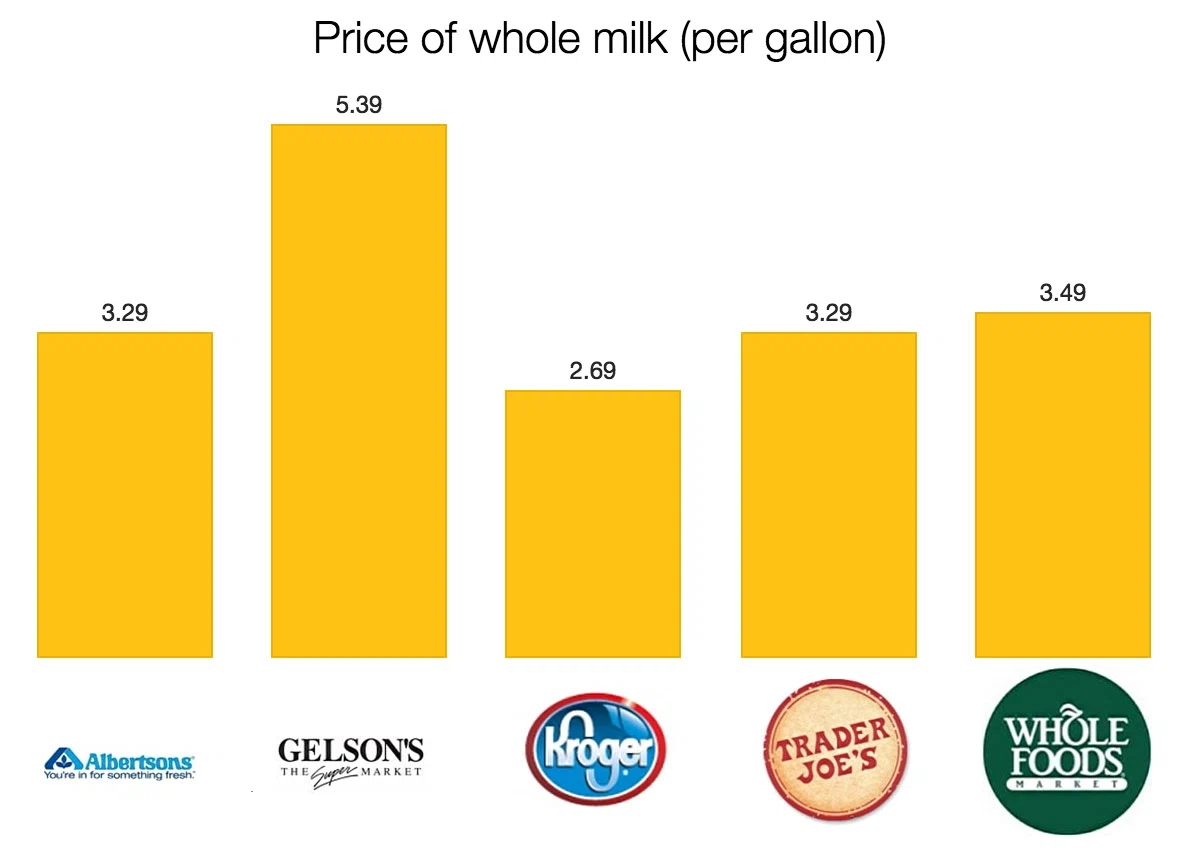Every shopper knows the pain of high grocery prices at supermarkets, but it’s often easier to stick with your primary supermarket than to look for cheaper alternatives.
Maybe it’s time for a change.
According to a recent national survey by Consumer Reports, which asked over 62,000 respondents to rate their satisfaction with the prices at their local supermarkets, only 60 percent of them said they were happy with how much they paid for groceries.
Gourmet supermarkets like Whole Foods, which are known for charging a premium for organic food, appeared as the most expensive while low-cost neighborhood stores like Trader Joe’s topped the chart for being the cheapest.
We at BluePromoCode take grocery shopping very seriously, which is why we went out and conducted a local survey at some of the nation’s most popular stores. Specifically, we searched for the lowest regular price for a gallon of whole milk to make sure that discounts or promotions didn’t affect our survey.
Here’s a summary of our findings:

Although these supermarkets were all within a 10-mile radius of one another in the Los Angeles metro area, they had different prices for essentially the same item. Supermarkets like Gelson’s, which place an emphasis on gourmet and organic products, had a much higher price for a gallon of whole milk than the average prices found at Albertson’s and Trader Joe’s.
Our survey goes hand-in-hand with the results of the Consumer Reports survey, which showed that supermarkets across America had vastly different price satisfaction levels from their customers.
Here is the Consumer Reports breakdown of the cheapest and most expensive supermarkets in America.
Cheapest Supermarkets
**1. Trader Joe’s**
Trader Joe’s nationwide stores offer competitive prices for staples like eggs, milk, and grains, which is why they’re a favorite among shoppers. You’ll also be able to find affordable gourmet items such as specialty peanut butter, organic ketchup, and olive oil popcorn, as well as more unusual delicacies like cocoa dusted truffles with toffee bits.
2. Fareway Stores
Fareway, a Midwestern chain of supermarkets, credit cleanliness and low prices as the chief drivers of its success. An example of just how low Fareway’s prices are, a weekly ad for April showed a half-gallon of milk for a dollar, a loaf of bread for 88 cents, and a can of pork and beans for 48 cents.
3. Market Basket
Located in the Northwest, Market Basket distinguishes itself from its competitors by routinely offering rock-bottom prices on typical grocery list items like fruits and vegetables. Unlike other low-cost grocers, Market Basket doesn’t use loyalty cards with its customers, guaranteeing the lowest prices for any customer who walks through its doors.
**4. Costco**
A juggernaut in the business of low-cost, membership-only retailing, Costco continues to top the charts with their affordable prices for household goods like toilet paper, detergent, and personal care items like toothbrushes and skincare products. As a symbol of its commitment to low prices, Costco continues to offer a hot dog and 20 oz soda drink for $1.50 – a price that has remained unchanged since 1985.
**5. WinCo**
WinCo was named by Business Insider in 2013 as “Walmart’s worst nightmare,” and for good reason. WinCo keeps its prices low by purchasing products directly from suppliers, removing the need for expensive middlemen. WinCo is also able to keep costs down by not accepting credit cards and requiring customers to bag their own groceries.
Most Expensive Supermarkets
**1. The Fresh Market**
A popular pain point for Fresh Market customers are the substantially higher prices on staple products like milk, eggs, and bread without a noticeable increase in quality. Some prices, such as $6 for a pound of ground beef or $30 for a bag of frozen rolls, were enough for customers to complain about The Fresh Market on Yelp.
**2. Whole Foods Market**
Jokingly called “Whole Paycheck,” by unsatisfied customers, Whole Foods has repeatedly earned the ire of its customers with higher-than-average prices for most products, which include pantry staples and typical household goods. A study conducted by Wolfe Research in 2014 showed that, on average, a Whole Foods basket of common grocery items costs between $30 and $50 more than the same basket at competing supermarkets.
**3. Harris-Teeter**
Located in the South, Harris-Teeter is known for its cleanliness, meticulous attention to detail, and broad selection of goods ranging from prepared entrees to a wide wine selection. All of this comes at a price, however, and a study conducted by Broke & Healthy found that the prices for common fruits and vegetables were anywhere from $0.50 to $1.60 higher than at competing stores like Walmart and Trader Joe’s.
4. Brookshire’s
While not as egregious as Whole Foods or The Fresh Market, Brookshire’s customers believe the prices are almost always higher than those found at Walmart. For some customers, these higher prices don’t necessarily outweigh the benefits, which include prepared food items like rotisserie chicken and specialty beer selections.
**5. Giant Eagle**
Many Giant Eagle shoppers agree that, although it may occasionally have great deals on certain groceries and specialty items, fruits and vegetables are still more expensive than the competition. This is largely confirmed by a 2011 food study that shows that Giant Eagle was cheapest for items like pork chops, but still topped the chart with its high produce prices.
